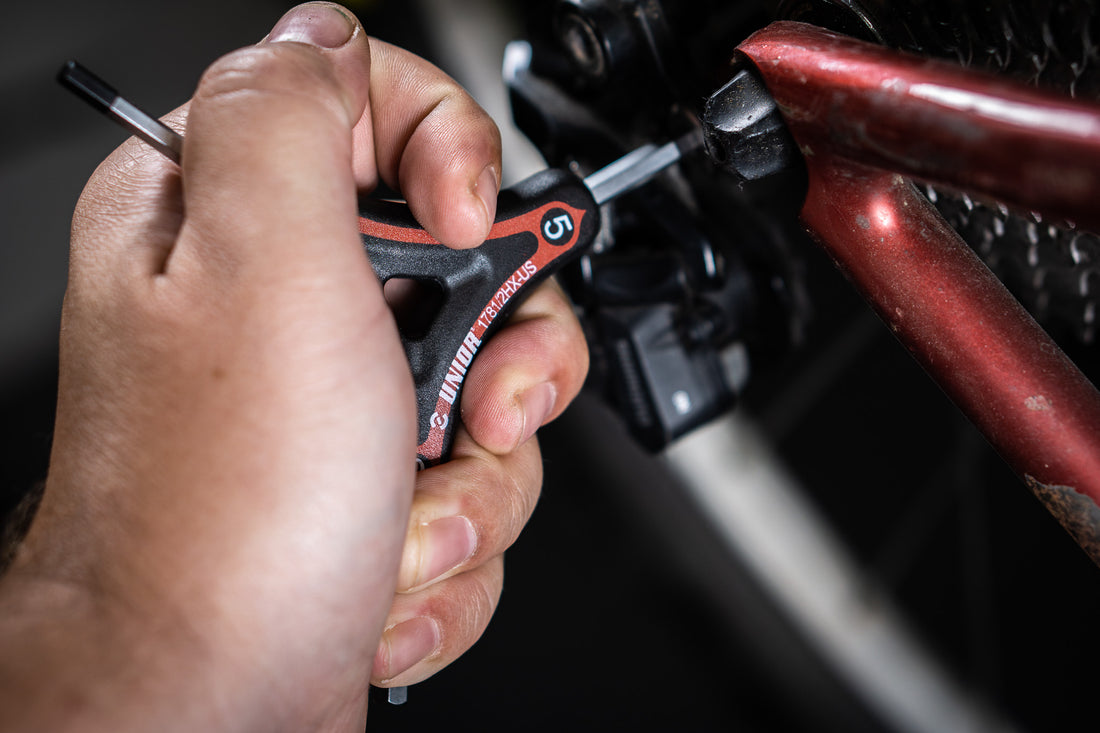
A Quick and Dirty Guide to Rear Derailleur Adjustment
Share
Nobody likes skipping gears, and being able to adjust yours quickly and easily will save you endless hours of headaches and frustration and queues at your local bike shop. It will however mean you’re one excuse down when you lose the town sign sprint, but on balance it’s worth it.
Well indexed gears rely on a few things: Correct cable tension, a straight derailleur hanger (which we covered in a previous article), properly set limit screws, and clean cables and housing. Your shifters are designed to pull a specific length of cable through at a set tension to function correctly, and any deviation can throw your shifting off. Before you begin, make 100% sure your mech is secure on the hanger - you can't perfect the imperfect!
Fine-tuning cable tension is done with a barrel adjuster. There are three types to look for. Sometimes you’ll have them at the shifter (more common on flat-bar bikes), sometimes at the rear derailleur, and sometimes there will even be one in-line on a section of housing somewhere. And sometimes you’ll even have a combination of the three. These work to adjust the tension on the inner cable by lengthening or shortening the housing length. Since the inner cable is fixed at each end, if you make a section of housing even a half a millimeter longer or shorter, it will have an effect on the inner cable tension.
The first step in getting that derailleur back to the quick, crispy, and responsive unit you’re used to is to align your derailleur hanger. That warranted its own article and you can read that here.

From there you’ll want to check your limit screws. These are two screws that limit (see where the name comes from?) how far inboard or outboard the derailleur can travel. One will be marked with an H for “high” and the other a L for “low”. The high limit controls how far the derailleur can move towards the small cog, the low limit controls how far the derailleur can move to the big cog.

Consider the high limit as the derailleur’s starting point. Without any cable tension, or no cable at all, this is where the derailleur will rest. We want to adjust this to where the upper derailleur pulley is in-line with (or slightly outboard of) the smallest cassette cog. Check the derailleur manufacturer’s instructions for specifics as it varies from brand-to-brand. We have to be aware though that if there is any tension on the derailleur cable then as much as we back out the limit screw the derailleur won’t be able to move, so let’s relieve that tension by turning our barrel adjuster inwards, or clockwise.
Once that limit screw is in its happy place we’re going to address our cable tension. While spinning the cranks shift the bike up to the next gear. If the derailleur overshoots the gear we have too much tension on the cable. If it doesn’t go up to the gear we don’t have enough. Since we slackened it to adjust the high limit it’s probably safe to assume we don’t have enough tension on the cable and that’ll reveal itself by the chain being sluggish to climb into the next gear, if it even does at all. So we’ll add tension to the cable by turning the barrel adjuster out (counter-clockwise) a quarter turn at a time until the bike shifts into gear.
Now spin the cranks and listen to the drivetrain. Even though the chain might be in gear the derailleur might still be off-position and you’ll hear it as the chain chatters away. Take a look at the alignment of the upper derailleur pulley and the cog. They ideally should be inline now. If not, we can give the barrel adjuster another ¼ or ½ turn as necessary to bring it into position.
Slowly go up and down through the gears to make sure the derailleur is doing its job. If things look/feel/sound good we’ve got one last task: setting the low limit.
The low limit is there to keep the derailleur from shifting into the spokes of your rear wheel. That is bad and oftentimes results in needing to replace spokes, a topic for another article. We want to turn that low limit far enough out that the chain can get into the biggest cog but not so far that it can overshift. My method is to carefully shift the bike into the biggest cog and dial in the low limit screw until it just starts to provide some resistance. That means it’s engaged with the moving bits of the derailleur. Shift down and back up to ensure the bike can get back into the big cog, and then carefully try to shift beyond. If you set the limit properly you shouldn’t be able to.
One thing to bear in mind is that shifting can perform slightly differently under load, and a perfectly indexed derailleur in the stand may not translate perfectly out on the road, so be prepared to make the occasional ¼ turn adjustment while waiting for your cappuccino, unless you’re cooked and really need those excuses for the sprints.
